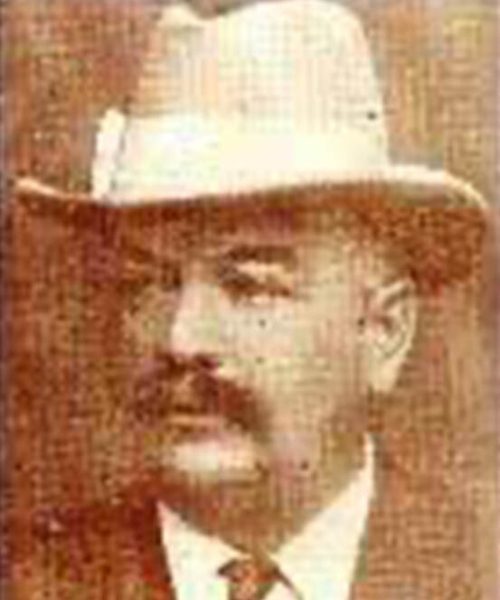
CONSTABLE WILLIAM E. KELLEY
AGE: 58
TOUR: 13 years
CAUSE: Gunfire
E.O.W: August 20, 1921
The first person appointed as Oxnard’s Police Chief upon the incorporation of the city in June 1903 was Samuel P. Lowe. He served for about six months, with the collateral assignment as tax collector. Lowe was succeeded by William Reno in 1903. Reno is actually considered the first Oxnard chief because Samuel Lowe agreed to take the job until someone could be hired to take over. Reno served as chief until 1907.
It was during Reno’s tenure that the first Oxnard Police Officer (known as constables) was killed in the line of duty. That was Andrew McNaughton in 1906. Unable to attract anyone to become police officers in the city, Reno resigned in 1907 and operated a “fix-it” shop in the area of Fifth and C streets.
William E. Kelley was hired as an Oxnard police officer in 1907, serving under then-chief William Reno. When Reno resigned, Kelley was appointed Chief.
If police officers could be awarded medals for bravery and heroic actions like the military, Chief Kelley would have earned at least three Purple Hearts. He was shot three different times over the course of his career a police officer.
In the 1891, while serving as a police officer in Minnesota, Chief Kelley was first wounded in the line of duty. While escorting a prisoner to jail, the prisoner suddenly produced a gun and shot Kelley in the leg. Kelley pulled his gun and killed the prisoner, shooting him four times before the prisoner hit the ground.
In 1914, he and three officers were sitting in a cigar store in the area of Third and A streets when a person came in, drew a revolver and shot Kelley and two of the other officers. New accounts of the day stated “In spite of a bullet wound two inches from his heart, Kelley sprang up and seized the would-be murderer and marched him off to jail after disarming him.
This year marks the 103rd anniversary of the death of Oxnard Constable Andrew McNaughton, the first Oxnard officer to lose his life in the line of duty. The sheriff would eventually bring McNaughton’s killer to justice. Remarkably, that same sheriff would make the ultimate sacrifice alongside the next Oxnard officer to be killed some 15 years later.
Wild West kind of town
The year was 1904. Oxnard was a Wild West kind of town and it had no lack of problems. Incorporated just a year earlier, the most infamous part of Oxnard was known as the Tenderloin District — the area immediately surrounding Seventh and A streets. It was part of the old Chinatown settlement where opium dens, outlaws and saloons ruled.
Knowing he could not protect this burgeoning town of 2,000 people on his own, city Marshal William Reno hired four deputy constables to assist him. Among the four was Andrew Murray McNaughton.
McNaughton was originally from New York. He moved to Oxnard to work at the American Sugar Beet Factory. He was 42, married and had four small children. Reno lured McNaughton away from the sugar factory with a hefty monthly salary of $75.
It was 1906. Marshal Reno and his men were a terror to the gambling and opium dens in Chinatown and they were making a collective impact on crime and disorder. But, during the night hours of March 16, Deputy Constable McNaughton was shot and killed while on foot patrol in China Alley. According to the Ventura Free Press, the precursor to the Ventura County Star:
“Mr. McNaughton had been active in following law-breakers among the gamblers and the residents of the half-world and it is thought he met his death at the hands of several men in a gang who were surprised in looting a pool room.
The untimely and shocking death of Mr. McNaughton at once plunged the town into a furor of excitement and caused an energetic crusade against vice by the city and county officials.”
The Free Press went on:
“Andrew had been selected for the position of night watchman and deputy constable for his bravery, fearlessness and strength. He had been particularly vigilant and had incurred the enmity of the lawless element and the desperadoes made frequent threats about putting him out of the way.”
It would take three years before Ventura County Sheriff Edmund Guy McMartin captured the killer of McNaughton. Again, quoting the Ventura Free Press:
“Ever since the murder of the Oxnard officer, Sheriff McMartin has never for a day, forgotten that somewhere (the killer of McNaughton) skulked and sneaked from the scrutiny of all men, evading the recognitions that would accomplish his capture and land him behind bars.”
In 1907, a new Oxnard city marshal rode into town. His name was William E. Kelley, a police officer originally from Minneapolis, Minn., and he came to be one of the great lawmen on the West Coast.
In 1921, Sheriff McMartin and Marshal Kelley teamed up to serve an arrest warrant on a fugitive in Owensmouth, the area now known as Canoga Park. As the lawmen approached the fugitive’s home, gunfire erupted and both McMartin and Kelley were fatally wounded. After shooting the two lawmen, the suspect fled into a nearby bean field pursued by some 100 ranchers and citizens. When the posse finally came upon him, it was found he had shot and killed himself.
Sheriff and marshal mourned
Hundreds of people turned out for the funerals of the sheriff and the marshal, just as they had for Deputy Constable McNaughton. Kelley was laid to rest in the mausoleum at Oxnard’s Santa Clara Cemetery.